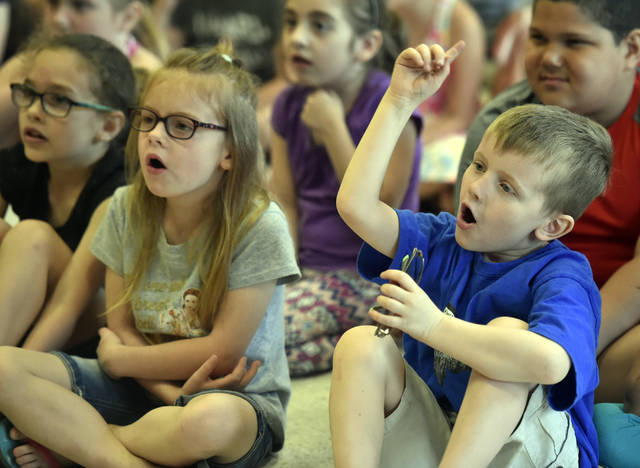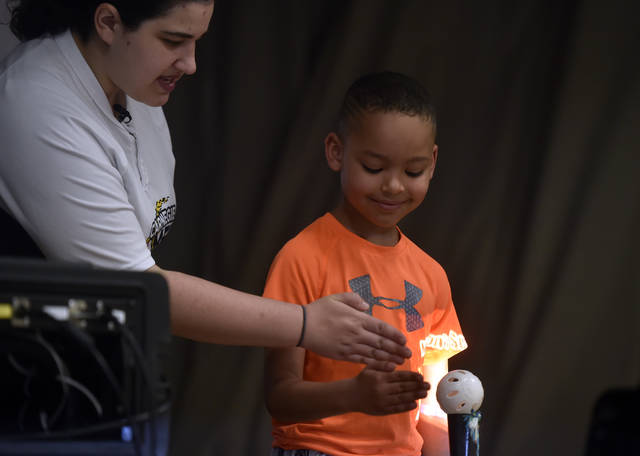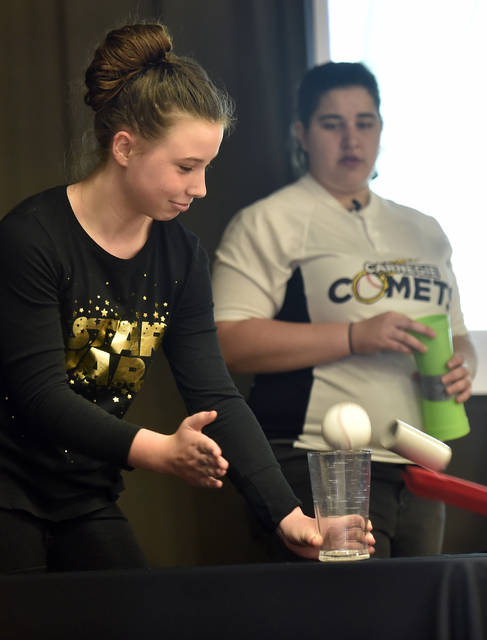ROSS TWP. — Nearly 216 Ross Elementary School students ditched class for baseball May 4.
The kids did not head out to the school’s field and choose teams. Instead, kindergarten through sixth-graders entered the gym to learn about the science in baseball with Aly Toy, of the Carnegie Science Center in Pittsburgh.
“We are going to talk about baseball and about science,” Toy said at the Grand Slam Science Show. “We are going to collide those two things together and make a special kind of science called physics.”
The science of physics is the study of how things move, she told the Ross Elementary School students in Sweet Valley.
But before batting out facts, Toy warmed up her audience with video clips of the Pittsburgh Pirates catching balls and batting. The video highlighted the players’ quick reactionary moves.
Then, Toy put the students to work with a simple exercise to learn the science behind reaction times.
On a big screen, she displayed the word Blue, but the color of the word was colored yellow. The challenge for students was to call out the name of the color, not the word.
Students tried to be on task, but the results consisted of giggles and many wrong answers.
“How many experienced a delay before yelling out their answer?” Toy asked.
Nearly 40 percent of the students raised their hands.
“That is because our brains are really good at reading words,” Toy said.
It takes time for our brains to sort through the confusion and find the right answer, she said.
“This is known as the Stroop Effect,” Toy said.
She had the students run through the visual exercise again. The result was faster responses with more correct answers.
“With practice, you can train your brain to do new things,” she said.
Then, Toy brought scientist Sir Isaac Newton’s Law of Motion up to bat.
She placed a batting tee on the gym floor. A softball was tethered to the tee with a rope to prevent it from rolling away.
Newton’s First Law of Motion is the Law of Inertia, which states “an object at rest stays at rest, and an object in motion stays in motion unless an external force is applied,” she said.
Toy looked down at the ball resting on the tee and said, “luckily I’m an ‘external force,’” and knocked the ball off the stand.
“What prevented it from rolling away?” She asked.
The rope stopped the ball from rolling, kindergartner Jacob Mock said.
Newton’s Second Law of Motion — Force equals Mass and Acceleration — also applies to the sport.
Toy held up a whiffle ball and a baseball and asked the students if the balls were the same size.
“Yes,” the group called out.
However, when she asked if they were the same mass, their answer was “no.”
The baseball “contains more stuff,” Toy said. Therefore, the baseball would need more force to create movement than the whiffle ball, she said.
Newton’s Third Law of Motion, “every action has an equal and opposite reaction,” required a demonstration.
Student volunteers kindergartner Sophia Watson and sixth-grader Brace Roote stood in front of their peers as Toy handed them each a same-sized black bouncy ball.
“These are really bouncy balls,” Toy said as she handed one to Sophia.
When she handed Roote his, the weight of the ball caused his arms to briefly lower.
On Toy’s signal, the students let go of the balls. Sophia chased her’s, which bounced over to her classmates.
Roote’s landed with a splat and did not move.
Roote’s ball was filled with sand, which absorbed the impact when the ball hit the floor and pushed the energy out to the sides of the ball, Toy said.
A baseball has the same reaction when hit by a bat, Toy said.
She played a slow-motion video showing how a pitched baseball gets squished by a batter’s swing.
“A ball traveling at 80 to 90 miles-per-hour has a lot of force,” she said, adding the bat’s impact with the ball does make a vibration, which could break the bat if it does not strike the ball in the proper spot.
That special spot on a bat that reduces vibration is commonly known as the ‘sweet spot,’ she said.
Second-grader Isabella Ungureit volunteered to help Toy find the ‘sweet spot’ on different sized bats that were hung by their handles.
Toy told Isabella to tap each bat and listen to the sound. The sweet spot will make a thud-like sound, she said.
The youngster slowly tested nearly a dozen bats and identified the ‘sweet spot’ on each one.
The Grand Slam Science is just one of several traveling science shows by the Carnegie Science Center. The assembly was hosted by the Ross Elementary School Parent Teacher Association.









